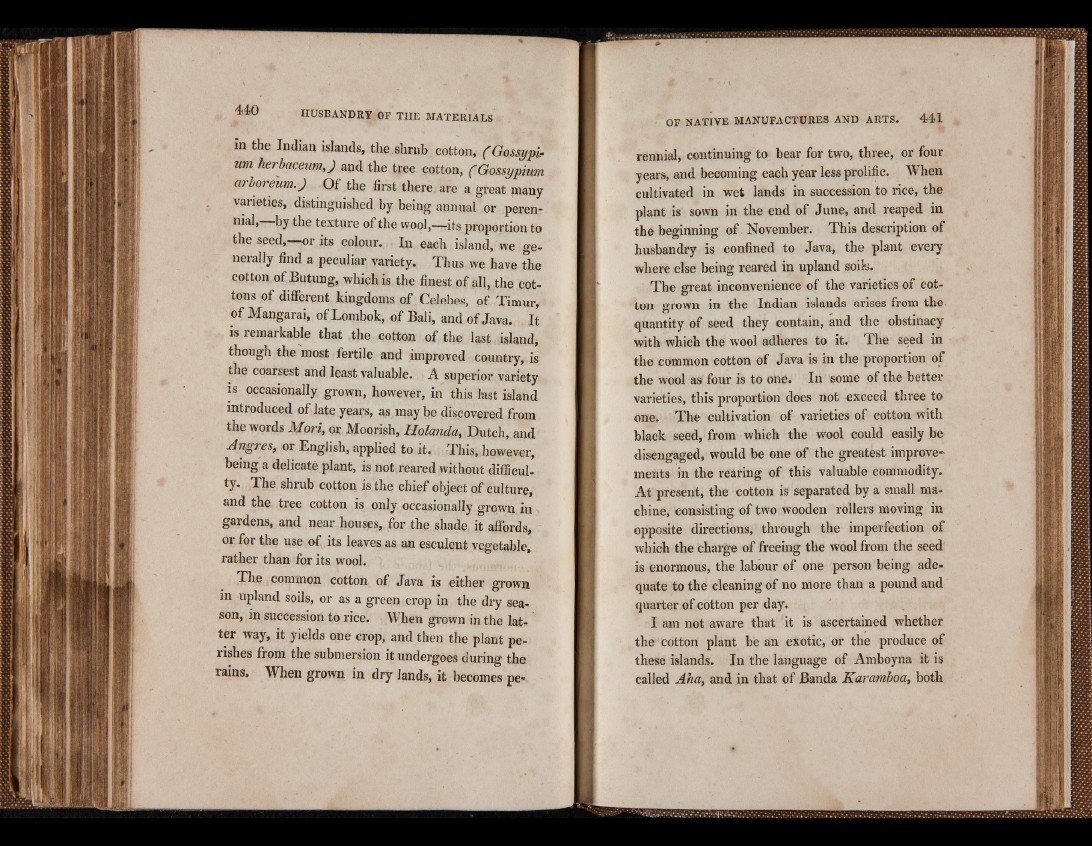
m the Indian islands, the shrub cotton, (Gossypi-
urn herbaceum,) and the tree cotton, ( Gossypium
arboreum.) Of the first there are a great many
varieties, distinguished by being annual or perennial,
by the texture of the wool,—its proportion to
the seed,—or its colour. In each island, we ge-
neially find a peculiar variety. Thus we have the
cotton of Butung, which is the finest of all, the cottons
of different kingdoms of Celebes, of Timur,
of Mangarai, of Lombok, of Bali, and of Java. It
is remarkable that the cotton of the last island,
though the most fertile and improved country, is
the coarsest and least valuable. A superior variety
is occasionally grown, however, in this last island
introduced of late years, as maybe discovered from
the words Mori, or Moorish, Holanda, Dutch, and
Angres, or English, applied to it. This, however,
being a delicate plant, is not reared without difficulty.
The shrub cotton is the chief object of culture,
and the tree cotton is only occasionally grown in
gardens, and near bouses, for the shade it affords,
or for the use of its leaves as an esculent vegetable,
rather than for its wool.
The common cotton of Java is either grown
in upland soils, or as a green crop in the dry season,
in succession to rice. When grown in the latter
way, it yields one crop, and then the plant perishes
from the submersion it undergoes during the
rains, When grown in dry lands, it becomes perennial,
continuing to bear for two, three, or four
years, and becoming each year less prolific. When
cultivated in wet lands in succession to rice, the
plant is sown in the end of June, and reaped in
the beginning of November. This description of
husbandry is confined to Java, the plant every
where else being reared in upland soik.
The areat inconvenience of the varieties of cot- o
ton grown in the Indian islands arises from the o ^
quantity of seed they contain, and the obstinacy
with which the wool adheres to it. The seed in
the common cotton of Java is in the proportion of
the wool as four is to one. In some of the better
varieties, this proportion does not exceed three to
one. The cultivation of varieties of cotton with
black seed, from which the wool could easily be
disengaged, would be one of the greatest improve-
ments in the rearing of this valuable commodity.
At present, the cotton is separated by a small machine,
consisting of two wooden rollers moving in
opposite directions, through the imperfection of
which the charge of freeing the wool from the seed
is enormous, the labour of one person being adequate
to the cleaning of no more than a pound and
quarter of cotton per day.
I am not aware that it is ascertained whether
the cotton plant be an exotic, or the produce of
these islands. In the language of Amboyna it is
called Aha, and in that of Banda Karamboa, both